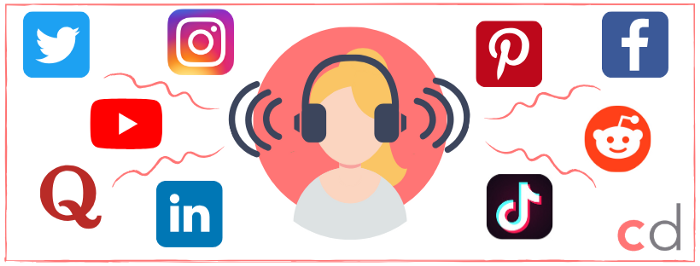Originally posted on Curated Medium.
The process of social listening has been a key topic within social media marketing, and the wider business space, for some time. But what does this really tell you about your customers, and is it being used to its full potential? Perhaps we need to pave the way for another similar, yet distinct, process that can run parallel to the traditional social listening research: customer insight analysis.
In this Q&A, Curated’s Social Media Lead, Danielle Smith, delves into these different research approaches, looking at the benefits of each, and the importance of understanding our customers in an ever-changing world and what this means for business. Social listening can get you so far, but customer analysis can really pave the way for business growth.
Why is customer insight so important now?
Well, it has always been important, it’s just that now we have the time to reflect and realise just how important it is. With the drastic changes, we have seen recently, customers are making it more known than ever what it is they want from the brands they engage with. Essentially, people are just really waking up to it now — customers are looking at brands differently, and brands have to adapt to meet their customers’ expectations at this time, and moving forward. In order to do that, we have to really understand our customers’ needs.
So, what is social listening?
The phrase ‘social listening’ has been bandied about for some time now, and its meaning and what it entails have evolved. For the majority of people, and brands, that talk about social listening, it is a process of understanding how people — existing and potential customers — are talking about your brand online, specifically on social channels.
As such, it is very brand-led: it monitors brand mentions, whether you’ve been tagged or not, brand sentiment, and conversation themes around your brand. It can also be used to track competitors; how do people engage with them compared to you, for example.
It is about understanding where you fit in the wider conversation, and it can also be used as a customer service and reputation management tool. There are heaps of tools out there that offer this type of social listening, based on accounts you want to monitor and keywords relevant to your brand.

How does this differ from customer insight then?
While social listening largely focuses on brand, customer insight research does exactly what it says on the tin: it puts the customer — and potential customer — first. While it uses a similar process to social listening, and many of the same tools, it takes brand largely out of the equation to focus on customer analysis. The research looks at keywords and themes that you want to monitor, without specifying particular brands to track, including your own.
Who are your customers? What topics are they discussing and what questions are they asking? Which platforms are they using — this primarily focuses on social, but can include other channels, such as forums, blogs, news sites, etc. What is their intent? What are they looking for? This opens the door to much greater, more in-depth, customer understanding.
How do you go about customer insight research?
We use a combination of automated tools and manual research. Like with the social listening approach, you can monitor specific keywords and themes relevant to the industry that you’re researching. Curated’s approach takes six key questions as our starting point — they are the same six questions you’ll have likely learned early on in school at a very basic level, and they are the same questions taught in journalism courses. We take this rather rudimentary approach and use it to guide us, before we can dig deeper into each area.
Those six questions are: who, what, where, when, why, and how? Sounds simple, right? But these questions can tell you a whole lot about your customers and the space you’re working in.

While this research can be done manually, the learnings you get may be limited. There are a lot of tools out there to help direct your research: for example, Keyhole, Mention, Sprout Social, SEMRush, Hootsuite. We’ve used a combination of all of these tools, as well as our own manual desk research to get the best results. We let the tools guide us at the start, and then use our own experience and insight to take on the more in-depth manual research.
“All of this means nothing without action”
But what do you get out of it?
Well, knowledge, for one thing — and, however clichéd it may be, knowledge is power. But it’s what we do with this new-found insight that really gives value to the research we have done. The more we know about our customers and potential customers, the better. It means we can reach them where they are, with topics we know they are talking about, giving them solutions to questions we know they’re asking. But all of this means nothing without action. The process of customer insight research is all geared towards what action you can take to make it all worthwhile.
Your findings should inform strategy, whether that’s social strategy, content strategy, paid media, or even wider business strategy. Now you know what themes your customers are discussing, you can create content around it. Now you know where they are having these conversations, you can reach them on those channels — either organically, or through paid advertising. Essentially, once you know who your customer is, you can far better serve them.
Not only can it help you reach new customers, it can help you retain and satisfy your existing customer base. It could even serve as a basis from which to dig deeper into your existing email database — perhaps providing the bedrock of a customer survey, for example, helping you to better understand and engage with them, boosting retention and customer satisfaction.
And then what?
This process is not a one time thing. It should be repeated, and regularly. Trends change, customer needs change, and especially on social channels, conversation changes every day — hell, every hour. Your strategies should change too in order to adapt and stay relevant. There is no use in carrying out this research once and letting it be. It has to be an iterative process, and it has to constantly update your business strategy. There is no point in seeing that your customer needs are evolving and not reacting to evolve your business.
For Curated, this research impacts two of our key services: gap analysis and assurance. Our gap analysis allows us to understand gaps in the market, from a content perspective. The customer insight research determines what questions our customers are asking beyond the Google search box. For our assurance piece, it’s more about those fast-moving trends and topics, and understanding how the conversation is evolving on social in real time, and how we, and our clients, need to react to that. We can then create the relevant content, distribute it on the right channels, to the correct audiences, in the tone and language they themselves are using, to meet customer demand.
What’s your advice for brands looking to carry out their own research?
Firstly, absolutely do it. If you do it right, and use the insights appropriately, it will be worth it every time. But think about your end goals first. Is this a brand perception venture? Or is it a question of understanding customer behaviour? If it’s about brand perception and understanding how your brand is viewed, a traditional social listening process is probably what you’re after.
If you want to understand your customers more — which we should all be doing more of — a wider customer insight piece is needed that puts brand to the side to some degree. Both are important and I recommend carrying out both processes, but they have different end goals.
Most importantly, both types of research require action at the end. Don’t just find the answers, do something with them. And don’t just do them once and leave it — repeat, re-examine, review.
If you’re ready to take on your own social listening or customer insight research and want some guidance from our team, don’t hesitate to get in touch with us here.



